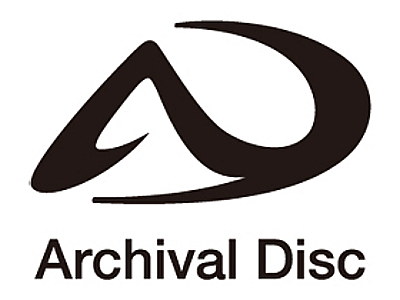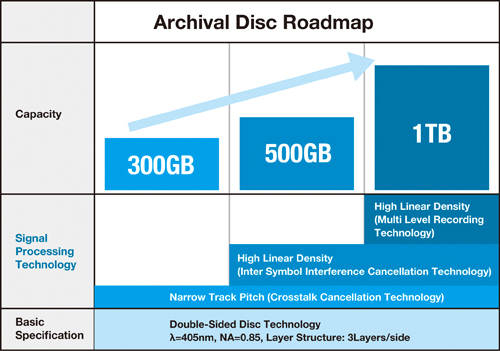Sony & Panasonic Optical Archival Disc Stores 300GB to 1TB
Sony and Panasonic talk more about their 300 GB optical disc.
For nearly two decades, CDs, DVDs and Blu-ray discs have served as the mainstream consumer's default storage solution outside saving data to the hard drive. These discs have properties to protect themselves against the environment including dust-resistance and water-resistance, and changes in temperature and humidity when stored. They also allow inter-generational compatibility between different formats so that data can continue to be read even as optical formats evolve.
Thanks to these properties, optical media has become a "robust" solution for long-term storage of content in the commercial sector as well as the consumer market. However, Sony and Panasonic have recognized that these optical formats just aren't big enough to store the large volumes of media that are expected in the near future.
"In recent times, demand for archival capabilities has increased significantly in the film industry, as well as in cloud data centers that handle big data, where advances in network services have caused data volumes to soar," states the companies' joint press release.
Thus after revealing their intentions back in July 2013, Sony and Panasonic finally introduced on Monday the Archival Disc, optical media that will initially provide 300 GB of storage. Both companies announced that they plan to launch systems with this recording capacity from summer 2015 onwards. They also plan to continue their collaboration to bring even more storage capacity to this new optical media.
According to their roadmap, the Archival Disc will offer 300 GB of storage using crosstalk cancellation technology on top of the double-sided disc specification. To provide 500 GB, they will implement intersymbol interference cancellation technology, and for 1 TB they will use Multi Level Recording technology.
The Archival discs will have the same dimensions as the current Blu-ray discs, will be double-sided packing three layers each side, and readable for at least 50 years. These discs won't even need a special controlled, storage environment, and have a lower power consumption compared to linear tape-open technology (LTO).
"Both Sony and Panasonic have successful experience working on the development of Blu-ray Disc technology. The two companies plan to actively promote this next-generation high-capacity optical disc standard in the professional field in order to offer an effective solution for protecting valuable data into the future," states the companies' press release.
Get Tom's Hardware's best news and in-depth reviews, straight to your inbox.
Here are the key Archival Disc specs:
- Disc size (type): 300 GB (write-once)
- Optical parameter: Wavelength λ=405 nm (nanometers), Numerical Aperture NA=0.85
- Disc structure: Double-sided Disc (3 layers/side), Land and Groove Format
- Track pitch: 0.225 μm (micrometers)
- Data bit length: 79.5 nm (nanometers)
- Error correction method: Reed-Solomon Code

Kevin Parrish has over a decade of experience as a writer, editor, and product tester. His work focused on computer hardware, networking equipment, smartphones, tablets, gaming consoles, and other internet-connected devices. His work has appeared in Tom's Hardware, Tom's Guide, Maximum PC, Digital Trends, Android Authority, How-To Geek, Lifewire, and others.
-
jn77 ReplyLet's hope there's a competing solution from the HD DVD camp eh?
I am pretty sure that a new HD DVD format won't be able to match the new stuff that is coming out. I have been waiting for a optical disk format to replace blu-ray because Sony's licensing fees are outragous for Blu-Ray...... the 100gb disks should be selling for $19 per 100 disk spindle by now. -
makaveli316 You probably should have kids in order to burn a disc with that amount of data, so they can take it out for you after you're dead. There's also the probability of electric failure for that amount of time you'll need to complete a disc......Reply -
Jgriff @makeveli By the time these become mainstream the technology viable to carry out a quick burn of 1tb of data should be out....you wouldn't release the platform if not.Reply -
wemakeourfuture Can't wait.Archiving HD video and DSLR pics on Blu-Ray still needs 50 blu-rays. As video and image expands want something to replace my archiving with less discs.Reply -
tcb1005 There will be no need for this format. Blu rays now can store up to 400 gb (With 16 layers), and by the time this will be available at an affordable price point, I don't think we will need optical media, and if we do, they will just pack in 2 Blu ray discs.Reply -
IQ11110002 Now if they can combine the superior tech of M disc(1000 years)which I already have with the much higher capacity of this new archive format, We will all be happy. Give me 1tb M Discs, Then I wont need all these hdd's.Reply -
stevenrix The price will remain prohibitive, probably as expensive as a 2.5 inch 1tb hard-drive.Reply

